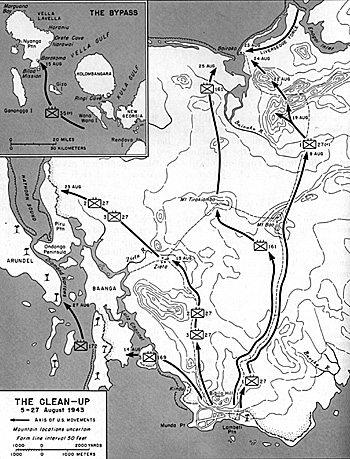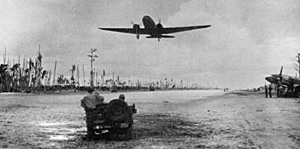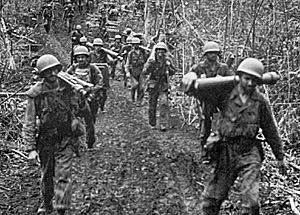 The hardest slugging was over, at least on New Georgia. But several tasks faced the
troops. The airfield had to be put into shape at once and the remaining Japanese had to be
cleaned out of New Georgia and several of the offshore islands. (Map 11)
The hardest slugging was over, at least on New Georgia. But several tasks faced the
troops. The airfield had to be put into shape at once and the remaining Japanese had to be
cleaned out of New Georgia and several of the offshore islands. (Map 11)
Map 11: The Clean-Up
Jumbo Map: The Clean-Up (very slow: 264K)
(Unless otherwise indicated this chapter is based on Craven and Cate, The Pacific: Guadalcanal to Saipan, pp. 237-44; Morison, Breaking the Bismarcks Barrier, pp. 225-39; ONI USN, Combat Narratives: Solomon Islands Campaign, XI, Kolornbangara and Vella Lavella, 6 August-7 October 1943 [Washington, 19441; SOPACBACOM, History of the New Georgia Campaign, Vol. I, Chs. VII-VIII; the rpts, jnls, and jnl files of NCOF, COMAIR New Georgia, XIV Corps, 25th Div, 43d Div, northern landing force, and component units; History of the 8th Area Army, 1942-44, Japanese Monogr NO. 37 (OCMH); 17th Army Operations, Vol. II, Japanese Monogr No. 40 (OCMH); Southeast Area Naval Operations, Vol. II, Japanese Monogr No. 49 (OCMH); outline of Southeast Area Naval Air Operations, August 1942-October 1942, Pt. II, Japanese Monogr No. 106 (OCMH). This section is also based on Building the Navy's Bases in World War II: History of the Bureau of Yards and Docks and the Civil Engineer Corps, 1940-1946, II (Washington, 1947), 265-66.)
The Airfield
Repair and enlargement of the battered airstrip began immediately after its capture."
"...Munda airfield looked like a slash of white coral in a Dore drawing of hell. It lay like a dead thing, between the torn, coffee-colored hills of Bibilo and Kokengolo." (John A. DeChant, Devilbirds: The Story of United States Marine Corps Aviation in World War II (New York: Harper & Brothers, 1947), P. 109.)
Seabees of the 73d and 24th Naval Construction Battalions began the work of widening, resurfacing, and regrading the field. On 9 August additional naval construction battalions added their tools and men to the task. Power shovels dug coral out of Kokengolo Hill, and bulldozers, earthmovers, graders, and rollers spread and flattened it. Good coral was plentiful, as were men and tools, and the work moved rapidly forward. By 7 August the field, although rough, was suitable for emergency wheels-up landings.
Advance parties from General Mulcahy's air headquarters moved from Rendova to Munda during the second week of August. On the 14th, the day after the first Allied plane landed, General Mulcahy flew from Rendova to Munda in his amphibian plane and opened Headquarters, Air Command, New Georgia, in a Japanese-dug tunnel in Kokengolo Hill.
Two Marine fighter squadrons (VMF 123 and VMF 124), with twelve Corsairs (F4U's) each, arrived on the 14th and began operations at once. Together with the fighters based at Segi Point, which were also under Mulcahy, they and other Allied squadrons covered the Allied landing at Vella Lavella on 15 August. (See below, pp. 179-80.)
There were some difficulties at first. Maintenance crews were inexperienced, there were not enough spare parts, the field was not complete, and taxiways and dispersal areas were small and in poor condition. Japanese naval guns, promptly nicknamed "Pistol Pete," shelled the airfield from the nearby islet of Baanga intermittently from 16 through ig August. But conditions quickly improved, and Pistol Pete, which had not done much damage, was captured by elements of the 43d Division on 19 August.
 MUNDA AIRFIELD IN OPERATION. C-47 transport taking off is evacuating wounded men.
MUNDA AIRFIELD IN OPERATION. C-47 transport taking off is evacuating wounded men.
As the field was enlarged, more planes and units continued to arrive. Operations intensified, and as the Japanese were cleared from the central Solomons Mulcahy's planes began to strike targets in the northern Solomons. For this reason his command was removed from the New Georgia Occupation Force on 23 September and assigned as part of the Air Command, Solomons. Mulcahy's fighters escorted bombers to the Bougainville bases, and Munda-based bombers soon began dropping loads there too.
Munda airfield, which by mid-October had a 6,000-foot coral-covercd runway and thus was suitable for bombers, became the best and most-used airfield in the Solomons. The rotation of Navy, Marine Corps, and Army Air Forces commanders that was standard in the South Pacific had brought about the relief of Admiral Mitscher as Commander, Aircraft, Solomons, by General Twining, the Thirteenth Air Force commander. General Twining moved his headquarters on 20 October from Guadalcanal to Munda and made the most intensive possible use of the new base.
Reinforcements
Airfield development, though of primary importance, could be of only minor interest to the ground troops who had the dreary task of slogging northward from Bibilo Hill in an attempt to trap the retreating Japanese. The job had been assigned to the 27th and 16ist Infantry Regiments, both operating under their parent command, the 25th Division.
Addition of the 27th Infantry to the New Georgia Occupation Force had come about because of General Griswold's urgent requests for more men. During July the Western Force of Task Force 31 had carried fully 26,748 men to Rendova (CTF 31 War Diary, 31 Jul 43 entry. Also transported were: 4,800 tons of rations; 17,431 drums of fuel, or 3,486 tons; 2,281 vehicles weighing 6,895 tons; 9,961 tons of ammunition; and 5,323 tons of other freight.) but by the month's end not that many men were available for combat. Many of the arrivals were service troops. Further, casualties and disease had weakened the infantry regiments.
 37TH DIVISION TROOPS CARRYING WEAPONS AND AMMUNITION forward, 5 August 1943.
37TH DIVISION TROOPS CARRYING WEAPONS AND AMMUNITION forward, 5 August 1943.
The three infantry regiments in the 37th Division (less the two battalions with Liversedge) had an authorized total strength of about 7,000 men. But the 161st Infantry, which entered the campaign below strength, was short 1,350 men. The two-battalion regiments were short too, so that the 37th Division's rifle regiments had only 5,200 men. And the 43d Division was in worse shape. With an authorized strength of 8,000 men, its three rifle regiments had but 4,536 men. Griswold had asked Liversedge if he could release two infantry battalions for the Munda drive but Liversedge replied that that would be possible only if Enogai and Rice Anchorage were abandoned. His raider battalions were then only 60 percent effective. (See XIV Corps G-3 Jul File, 28-29, 31 Jul 43BY 14 August sickness and casualties had rendered the 4th Marine Raider Battalion practically unfit for fighting. The battalion surgeon, Lt. J. C. Lockhart, USNR, reported that out Of 453 men present only 137 were fit for duty. Memo, 4th Mar Raider Bn Surgeon for CO 4th Mar Raider Bn, 14 Aug 43, sub: Health of Personnel Of 4th Raider Bn, in XIV Corps G-3 Jul File, 23 Aug 43.)
On 28 July Griswold asked Harmon for replacements or for a regimental combat team less artillery. This request posed a grave problem for Harmon and Admiral Halsey. The injunction against committing major forces to New Georgia was still in effect; at least it was theoretically in effect, for in small island warfare, especially in 1943, 26,000 men constituted a major force. The only immediately available division was the 25th, and one of its regiments, the 161st, had been sent in fairly early. Further, Halsey and Harmon had planned to use the 25th for the invasion of the Buin-Faisi area of Bougainville.
Yet as long as the high command retained confidence in Griswold, there could be but one answer. As Harmon wrote to his chief of staff, Brig. Gen. Allison J. Barnett, ". . . we have to make this Munda-Bairoko business go and as quickly as possible. It is the job 'in hand' and whatever we use we have to get it done before we go on to the next step."
Difficulties
One of the major difficulties, according to Harmon, was the fact that the Americans had underestimated the job in hand. "Munda is a tough nut--much tougher in terrain, organization of the ground and determination of the Jap than we had thought. . . . In both Guadalcanal and New Georgia we greatly underestimated the force require to do the job." (Ltr, Harmon to Barnett, 28 Jul 43, quoted in SOPACBACOM, History of the New Georgia Campaign, Vol. I, Ch. IV, P. 35, OCMH.)
Thus Harmon alerted the 27th Infantry of the 25th Division for transfer to New Georgia and recommended to Halsey that the 25th Division be taken off the list for Bougainville. (He suggested substituting the 2d Marine Division or the 3d New Zealand Division.)
As soon as he received Halsey's approval Harmon ordered up the 27th Infantry. On 29 July Col. Thomas D. Roberts of Harmon's staff arrived at Griswold's headquarters to announce the imminent arrival of the 27th Infantry and some replacements.
At this time the Japanese were still holding the Ilangana-Shimizu Hill-Horseshoe Hill-Bartley Ridge defense line, and no one was anticipating the rapid advances that characterized the first days of August. Thus on 30 July with Colonel Roberts' concurrence Griswold asked for more 25th Division troops and Harmon promptly promised the 35th Infantry.
Advance elements of the 27th Infantry, and Headquarters, 25th Division, landed on the barrier island of Sasavele on 1 August, and in the next few days the regiment was moved to the right (north) flank of the Munda front to protect the XIV Corps' right flank and rear.
More After Munda
- The Airfield
Cleaning Up
Plans
Seizure of Barakoma
Final Operations
Jumbo Map: The Clean-Up (very slow: 264K)
Back to Table of Contents -- Operation Cartwheel
Back to World War Two: US Army List of Issues
Back to MagWeb Magazine List
© Copyright 2002 by Coalition Web, Inc.
This article appears in MagWeb (Magazine Web) on the Internet World Wide Web.
Other military history articles and gaming articles are available at http://www.magweb.com